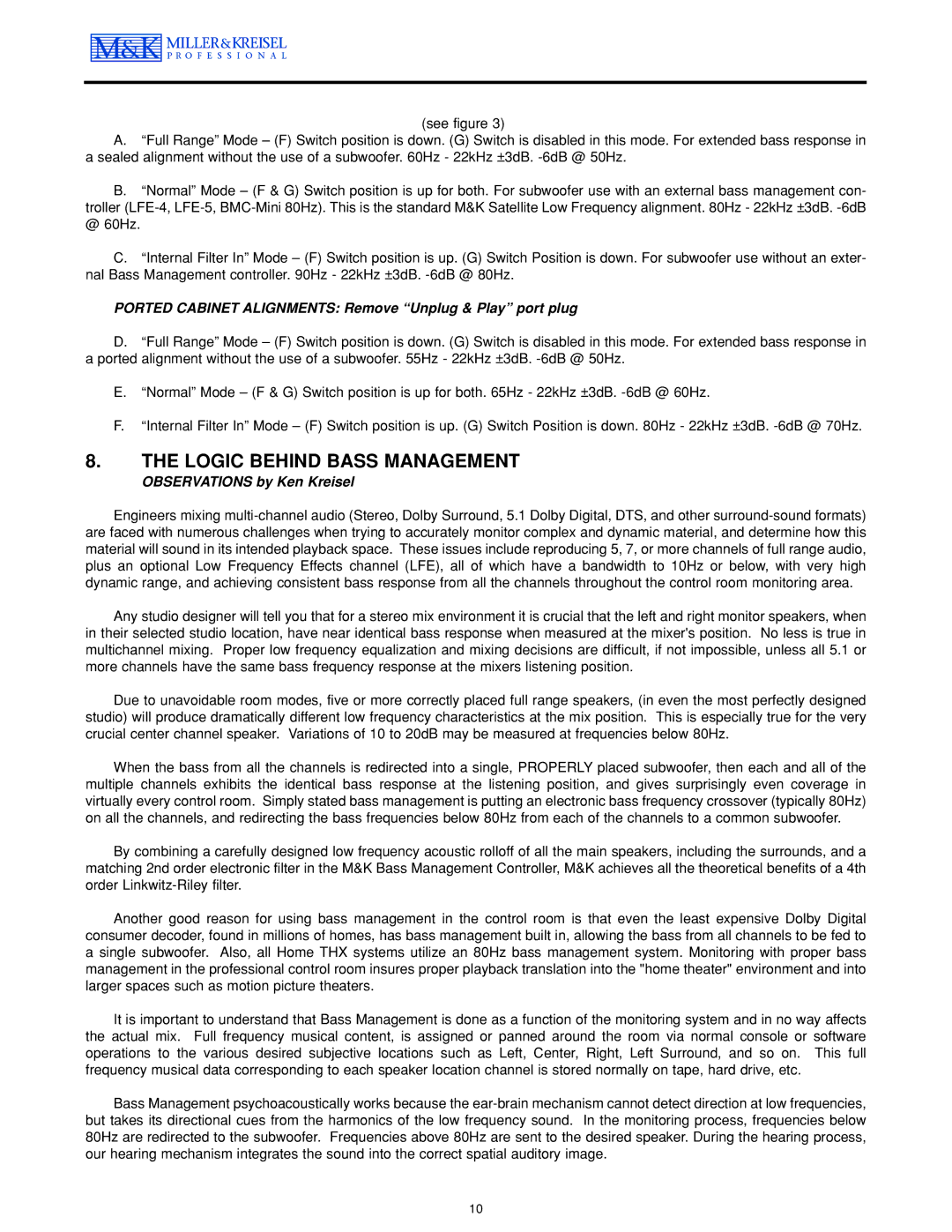(see figure 3)
A.“Full Range” Mode – (F) Switch position is down. (G) Switch is disabled in this mode. For extended bass response in a sealed alignment without the use of a subwoofer. 60Hz - 22kHz ±3dB. -6dB @ 50Hz.
B.“Normal” Mode – (F & G) Switch position is up for both. For subwoofer use with an external bass management con- troller (LFE-4, LFE-5, BMC-Mini 80Hz). This is the standard M&K Satellite Low Frequency alignment. 80Hz - 22kHz ±3dB. -6dB
@60Hz.
C.“Internal Filter In” Mode – (F) Switch position is up. (G) Switch Position is down. For subwoofer use without an exter- nal Bass Management controller. 90Hz - 22kHz ±3dB. -6dB @ 80Hz.
PORTED CABINET ALIGNMENTS: Remove “Unplug & Play” port plug
D.“Full Range” Mode – (F) Switch position is down. (G) Switch is disabled in this mode. For extended bass response in a ported alignment without the use of a subwoofer. 55Hz - 22kHz ±3dB. -6dB @ 50Hz.
E.“Normal” Mode – (F & G) Switch position is up for both. 65Hz - 22kHz ±3dB. -6dB @ 60Hz.
F.“Internal Filter In” Mode – (F) Switch position is up. (G) Switch Position is down. 80Hz - 22kHz ±3dB. -6dB @ 70Hz.
8.THE LOGIC BEHIND BASS MANAGEMENT
OBSERVATIONS by Ken Kreisel
Engineers mixing multi-channel audio (Stereo, Dolby Surround, 5.1 Dolby Digital, DTS, and other surround-sound formats) are faced with numerous challenges when trying to accurately monitor complex and dynamic material, and determine how this material will sound in its intended playback space. These issues include reproducing 5, 7, or more channels of full range audio, plus an optional Low Frequency Effects channel (LFE), all of which have a bandwidth to 10Hz or below, with very high dynamic range, and achieving consistent bass response from all the channels throughout the control room monitoring area.
Any studio designer will tell you that for a stereo mix environment it is crucial that the left and right monitor speakers, when in their selected studio location, have near identical bass response when measured at the mixer's position. No less is true in multichannel mixing. Proper low frequency equalization and mixing decisions are difficult, if not impossible, unless all 5.1 or more channels have the same bass frequency response at the mixers listening position.
Due to unavoidable room modes, five or more correctly placed full range speakers, (in even the most perfectly designed studio) will produce dramatically different low frequency characteristics at the mix position. This is especially true for the very crucial center channel speaker. Variations of 10 to 20dB may be measured at frequencies below 80Hz.
When the bass from all the channels is redirected into a single, PROPERLY placed subwoofer, then each and all of the multiple channels exhibits the identical bass response at the listening position, and gives surprisingly even coverage in virtually every control room. Simply stated bass management is putting an electronic bass frequency crossover (typically 80Hz) on all the channels, and redirecting the bass frequencies below 80Hz from each of the channels to a common subwoofer.
By combining a carefully designed low frequency acoustic rolloff of all the main speakers, including the surrounds, and a matching 2nd order electronic filter in the M&K Bass Management Controller, M&K achieves all the theoretical benefits of a 4th order Linkwitz-Riley filter.
Another good reason for using bass management in the control room is that even the least expensive Dolby Digital consumer decoder, found in millions of homes, has bass management built in, allowing the bass from all channels to be fed to a single subwoofer. Also, all Home THX systems utilize an 80Hz bass management system. Monitoring with proper bass management in the professional control room insures proper playback translation into the "home theater" environment and into larger spaces such as motion picture theaters.
It is important to understand that Bass Management is done as a function of the monitoring system and in no way affects the actual mix. Full frequency musical content, is assigned or panned around the room via normal console or software operations to the various desired subjective locations such as Left, Center, Right, Left Surround, and so on. This full frequency musical data corresponding to each speaker location channel is stored normally on tape, hard drive, etc.
Bass Management psychoacoustically works because the ear-brain mechanism cannot detect direction at low frequencies, but takes its directional cues from the harmonics of the low frequency sound. In the monitoring process, frequencies below 80Hz are redirected to the subwoofer. Frequencies above 80Hz are sent to the desired speaker. During the hearing process, our hearing mechanism integrates the sound into the correct spatial auditory image.
